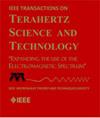利用非制冷、低 NEP SiGe HBT 太赫兹直接探测器实现无源成像
IF 3.9
2区 工程技术
Q2 ENGINEERING, ELECTRICAL & ELECTRONIC
IEEE Transactions on Terahertz Science and Technology
Pub Date : 2024-07-23
DOI:10.1109/TTHZ.2024.3432619
引用次数: 0
摘要
这项工作的重点是系统分析现代 SiGe HBT 器件在低太赫兹范围内进行宽带室温无源探测的潜力和局限性。要实现宽带无源成像并具有足够低的带内 NEP,需要满足多个必要条件,这些条件涉及各种技术驱动的器件操作方面,包括太赫兹整流过程和低频分析。为了正确理解和模拟器件的内部寄生,并结合天线-探测器协同设计方面的问题,对工作在前向有源和饱和区域(冷工作)的器件采用了简化的非线性高频探测器模型。完整的检测器是在现代高速 130 纳米 SiGe HBT 技术中实现的,其 $f_{t}/f_{text{max}}$ 为 470/650 GHz。它在单个双极化透镜耦合片上天线内包含两个正交极化路径,可在无极化被动照明下工作。由于采用了高效的天线-电路协同设计,在近 THz 分数带宽内实现了接近最佳的探测器性能,这一点已在使用频率可调相干 CW 源进行自由空间测量时得到实验验证。对每个偏振路径的探测器光学 NEP 进行了跨 200-1000 GHz 的测量,报告的最先进值为 2.3-23 pW/\$mathrm\{sqrt{Hz}}$(前向有效)和 4.3-45 pW/\$mathrm\{sqrt{Hz}}$(饱和)。这与 430 GHz 附近 512 GHz 的去嵌入式等效噪声带宽相结合,使得在 1.5 kHz 机械斩波的聚焦腔黑体标准下,1 Hz 定义的 NETD 分别为 0.86 K 和 2 K。通过双通道运行,NETD 降至 0.64 K,表明两个极化路径之间的噪声相关性几乎为零。本文章由计算机程序翻译,如有差异,请以英文原文为准。
Towards Passive Imaging With Uncooled, Low-NEP SiGe HBT Terahertz Direct Detectors
This work focuses on a systematic analysis of the potential and limitations of modern SiGe HBT devices for broadband passive room-temperature detection in the lower THz range. Multiple necessary conditions need to be fulfilled to facilitate broadband passive imaging with a sufficiently low in-band NEP, which refer to various technology-driven device operation aspects, including the THz rectification process and low-frequency analysis. To properly understand and model the devices' internal parasitics in combination with antenna-detector co-design aspects, a simplified nonlinear high-frequency detector model was applied for the devices operating in the forward-active and saturation region (cold operation). The complete detector was implemented in a modern high-speed 130 nm SiGe HBT technology with
$f_{t}/f_{\text{max}}$ $\mathrm{\sqrt{Hz}}$ $\mathrm{\sqrt{Hz}}$
求助全文
通过发布文献求助,成功后即可免费获取论文全文。
去求助
来源期刊

IEEE Transactions on Terahertz Science and Technology
ENGINEERING, ELECTRICAL & ELECTRONIC-OPTICS
CiteScore
7.10
自引率
9.40%
发文量
102
期刊介绍:
IEEE Transactions on Terahertz Science and Technology focuses on original research on Terahertz theory, techniques, and applications as they relate to components, devices, circuits, and systems involving the generation, transmission, and detection of Terahertz waves.
 求助内容:
求助内容: 应助结果提醒方式:
应助结果提醒方式:


